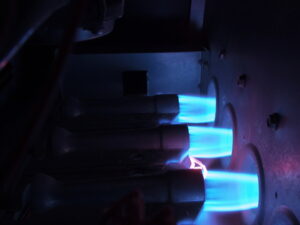The need for furnace repair in Warren, NJ never seems to come at a convenient time. Although there are some furnace issues that can wait a bit, there are some potential problems that should be addressed immediately. One of these is a cracked heat exchanger.
If you have a gas furnace, a cracked heat exchanger is a safety issue that can pose potential health hazards to you and your family. Let’s take an in-depth look at this essential part of your furnace. By knowing the signs of a cracked heat exchanger, you’ll know when to call for immediate furnace repairs.
Why Is a Cracked Heat Exchanger a Serious Issue?
The reason a crack in a heat exchanger poses serious problems is because it has the potential to release hazardous gases into your home. To understand how it’s possible, it helps to know how a heat exchanger works.
The aptly named heat exchanger is the part of a furnace that is responsible for transferring heat into your home. Here are the steps involved.
- The heat exchanger is a metal container that collects the combustion gases.
- The combustion gases heat the metal walls, raising the temperature and causing the exchanger to burn hot.
- Air from the blower moves around the exchanger and picks up the heated air before it passes into the ventilation system.
- The remaining combustion exhaust in the exchanger is then sent through a flue to escape to the outside air.
What Causes Heat Exchangers to Crack?
Basically, these cracks can develop through wear and tear. That’s why cracked heat exchangers are more likely in older furnaces. Every time you use your gas furnace, the heat exchanger’s metal chambers expand as they heat up and contract as they cool down. It’s a constant cycle of expansion and contraction. Eventually, all this strain can cause cracks to develop.
How Can I Tell If My Heat Exchanger Is Cracked?
Unfortunately, cracks in a heat exchanger aren’t visible to the naked eye. You’ll need to depend on your other senses to learn the other signs to know if this is happening in your home. Gas leaks in your home will smell like rotten eggs, sulfur, or formaldehyde due to the additives that are added to natural gas by utility companies.
If the gas leak is bad enough, it’ll set off your carbon monoxide monitor. Another sound you could hear is the sound of the furnace making a clicking noise after the blower shuts off.
What Should I Do if I Suspect My Heat Exchanger Is Cracked?
The first thing you should do is shut the furnace down. If anyone in your home is experiencing symptoms of carbon monoxide poisoning, you’ll need to evacuate your home and call emergency services. Some of the signs of CO poisoning include nausea, vomiting, headaches, dizziness, mental confusion, weakness, nausea, and chest pain. The next step should be reaching out to a professional HVAC company like ours for immediate repairs.
Established in 1912, Max Sr & Paul Schoenwalder Plumbing, Heating and Air Conditioning, A Corp. is your trusted resource for reliable furnace repair services. Reach out to us today.

